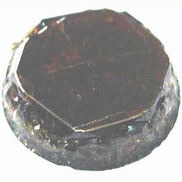Virtual Reactor (AlN) 4.8
 Fig. 1.
AlN Crystal |
Part 1: Heat Transfer Modeling
Modeling of the global heat transfer problem in a system for SiC crystal growth, including
- Inductive heating. The computation of the Joule heat sources due to inductive heating is carried out by solving the Maxwell equations.
- Conductive heat transfer in solid materials and gas domains. The thermal conductivity of the materials used in the growth system can be prescribed by the user as a function of temperature. Anisotropic thermal conductivity can be assigned.
- Heat transfer in the AlN powder. Effective heat conductivity is calculated from the powder characteristics (local porosity and granule size).
- Convective and radiative heat transfer in transparent gas blocks. The view-factor technique is used to model the radiation heat exchange. All solid blocks are assumed to be opaque for the radiation.
Computation of the thermal stress distribution in the crystal, including the density of gliding dislocations in the crystal calculated on the assumption of a full stress relaxation due to plastic deformation.
Visualization of the obtained results.
Convective heat transfer simulation can be added to the thermal module on the customer request. The subject will be implemented in two weeks after request confirmation.
The software supply will include a Database of Material Properties, User Manual, Context Help, and Sample files.
Part 2: Mass Transport Modeling
Modeling of the mass transport in the clearance between the powder and the seed includes
- Diffusion of Al and N2 species.
- Convective flow.
Prediction of the total vapor pressure inside the tightly closed or semi-closed growth chamber.
The following boundary conditions for the mass transport problem to be solved in the gas cell are available:
- Chemically reactive surfaces of the seed, growing crystal and the crucible. A quasi-thermodynamic model is used to describe the mass exchange between the vapor and solid surface.
- Thin slits at the contacts of the crucible elements allowing for mass leakage from the growth chamber.
- Inlets and Outlets.
Modeling of mass transport in the AlN powder charge. The model includes a set of mass transport equations accounting for heterogeneous chemical reactions at the surface of AlN granules. The powder characteristics (porosity, granule size) can be specified independently for several powder regions.
Crystal evolution during the growth within the quasi-stationary approximation described above.
Powder evolution during the growth, which includes prediction of the temporal variation of all powder characteristics (local porosity, granule size, and graphitization degree).
Visualization of the obtained results.
The software supply will include a Database of Material Properties, User Manual, Context Help, and Sample files.
Part 3: Additional Modules that can be added to the Basic Version of the VR-AlN code
Module for analysis of dislocations dynamics.
A module providing analysis of the propagation of threading
{1010}<1210> and {1010}<0001> dislocations can be implemented
into the basic version of the Virtual reactor on the customer
request. It is used as a post-processing tool. A pre-computed
sequence of consecutive crystal shapes corresponding to all time
instants of the virtual growth process, at which the heat- and
mass transport problems were solved, are used to start the
dislocation analysis. This option provides 2D propagation of
dislocations originating from the seed in a selected vertical
crystal cross-section and the dislocation outcrop mapping in
a set of horizontal crystal cuts.
